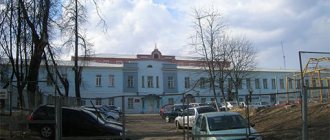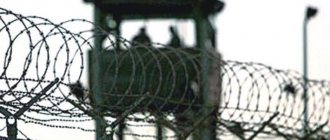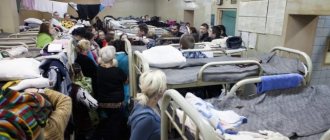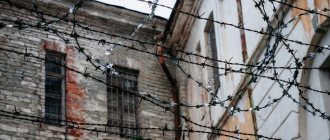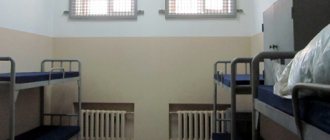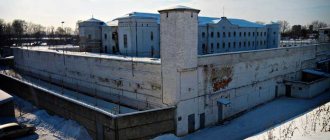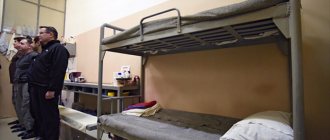On October 22, it became known that the number of prisoners in Russian colonies and pre-trial detention centers had reached a historical minimum, as reported by the press bureau of the Federal Penitentiary Service (FSIN). As there are fewer and fewer prisoners, many places of deprivation of liberty, once famous throughout the country, are falling into disrepair. Abandoned camps, prisons and pre-trial detention centers today can be found in various parts of Russia - from Magadan to St. Petersburg. Photographer Alexander Sukharev found out what the dead zones, where prison life once flourished, look like today.
The concepts of prison, zone and camp
Andrey, if it’s not difficult for you, please enlighten me on how the concepts of “prison”, “zone”, “camp” differ from each other, otherwise I’m completely confused. Thank you in advance. Nyusha
A prison is what is also called a pre-trial detention center, essentially an indoor regime. Those. people are kept in cells all the time, walk for an hour a day, and are taken out for walks under escort. Zone and camp are synonymous; officially their names are “correctional facility.” This is the uncovered mode. Those. people are in a dormitory, almost the same as an army barracks. There are shared bedrooms for the whole squad, and there are separate bedrooms for several people. You can always go outside to the courtyard. Usually the courtyard is locked at night with a gate, it is surrounded by bars and is a local area. And these concepts overlap quite widely. So in the camps there are punishment cells (punishment cells) and strict regime, which are like a prison within a prison. In prisons there are economic detachments made up of convicts; the regime there is easier than in the rest of the prison, but movement is only accompanied. There are also indoor camps, i.e. essentially a prison. Of course, such camps are only for special categories of prisoners, for example, for those sentenced to life or long terms.
Post navigation
Former military commandant's office of the Vyborg garrison
The building of the Vyborg police department (now Leningrad region) consisted of two separate buildings. The first one, on the corner of Progonnaya Street and Market Square, was built in 1797 and was intended for a nautical school. But in the 60s of the 19th century, this building along with the site was transferred to the city police department.
5. Former military commandant's office of the Vyborg garrison, Leningrad region. Photo: Alexander Sukharev
In 1867, a two-story stone building was built on the part of the site overlooking the Market Square. In 1933, the building was rebuilt again according to the design of the architect Uno Ulberg: he connected both buildings with a semicircular building of police barracks. After 1944, instead of the police department, the building housed a military commandant's office, and the semicircular building was assigned to the Vyborg garrison guardhouse.
Former military commandant's office of the Vyborg garrison, Leningrad region. Photo: Alexander Sukharev
Places of detention - what are they?
According to the terminology that explains what a prison is, it is said that a prison is a qualified correctional institution with a strict regime for serving criminal and other types of illegal acts punishable by a prison term.
In prison, prisoners have a minimum amount of freedoms and rights, and it is simply impossible to show any individuality in this correctional place. Very often, a prison is a separate building, the territory of which has its own access control regime. In addition, security forces are always on duty to maintain order in the prison, regardless of the time of year, day or weather conditions. There are also several different degrees and levels of security in a prison.
Features of a maximum security colony
Correctional colonies of this type exist for those sentenced to life or those whose death penalty was commuted to life imprisonment.
Maximum security correctional colonies house men who have been convicted for the first time of committing particularly serious crimes. Male recidivists who have previously served imprisonment are also placed there. In this article we will try to tell a little about what exactly they are. First of all, this is a place with limited movement. It would be more accurate to say that there is practically none. In prison, people are in a cell 24/7.
What is a zone
A zone in a simple interpretation of this definition can be characterized as a small-sized closed and guarded town. Here, too, there is a security pass, several levels of security, and several other aspects similar to a prison. However, there is much more personal freedom here.
For example, in some cases, prisoners can walk around the zone, visit the canteen, library, or even a local club. According to official data, a prison and a zone, and what is their difference, are places for deprivation of liberty that appeared (especially zones) as a result of numerous repressions at the beginning of the last century.
Based on everything said above, it can be noted that comparing these terms is not entirely correct. But the whole point is that prison is the official name of places intended for serving various types of sentences, and zone is most of all a colloquial term.
An important point: in some cases, the definition of “zone” can generally be understood as the entire path of a person, starting from the isolation ward and ending directly with imprisonment.
Camp Omchak
The abandoned forced labor camp (ITL) Omchak is located next to the village of the same name in the Magadan region. Omchak and the center of the region - the city of Magadan - are separated by 370 kilometers, which can be overcome along the Tenkinsky highway.
Photo: Alexander Sukharev
The village of Omchak was founded in the 40s of the 20th century to develop gold mines. And prisoners from the labor camp located next door were employed in the mining industry.
Photo: Alexander Sukharev
The Omchak camp was known in the criminal world because of its striped uniform - it was worn by prisoners who received 25 years in prison. ITL was finally disbanded in the late 90s. Today, only the latest buildings have survived.
Photo: Alexander Sukharev
Help from a lawyer
A lawyer can help determine the type of punishment, as well as where exactly the defendant will have to serve his sentence. A qualified lawyer will help, first of all, by collecting a complete evidence base, as well as legal advice. In the event that it is impossible to cancel the punishment, that is, to find the accused innocent, a qualified lawyer will do everything necessary to mitigate the punishment or the terms and place of serving the sentence.
For example, if a defendant is sentenced to prison, a lawyer can gather all the evidence to reduce the sentence. In this case, the person will serve his sentence in the “zone,” that is, in a guarded settlement, within the territory of which one can move freely and visit clubs, canteens and libraries.
A professional lawyer knows what a zone and a prison are, and also knows what is their difference and how to use the features of a prison and a zone in the process of conducting criminal and other types of cases in court proceedings.
It's better to stay at home than in prison
One of the proofs that the zone and the prison are not identical places, but completely different, is creativity. Both the zone and the prison sing songs in the chanson genre. It is there that creative authors talk about being in the zone, automatically contrasting this place with a prison.
Also keep in mind that without an application (another piece of paper), you will not be able to see the prisoner, nor send or make a parcel to him.
Prison is a type of correctional institution. It is a one- or multi-story brick building or several buildings, inside of which there are cells for convicts (general and solitary) and all the necessary premises, including administrative ones.
It’s worth figuring out whether these concepts mean the same thing or whether there are differences. And if so, what is the difference between a prison and a zone?
Differences between prison and zone
There are several significant differences between the zone and the prison, which are reflected in the life of each prisoner. The main points in which prison and zone differ are the following:
- Restrictions on rights. A prison is a room of four walls, a ceiling and a floor, where a prisoner sees fellow inmates, even aggressive ones. Zone – you can move around the territory limited by a fence;
- Hierarchy. Social differentiation exists only in cells where there is a “rooster” and “authority”. There are also authorities in the zone, but here the relations between prisoners are simpler;
- Content. Prison corrects a person by confining him for a long time. As for the zone, here we are talking about a ban on benefits. Therefore, in the zone you can walk, walk and even get an education;
- Occupations - In prison, inmates perform a wide range of different chores, with no job assigned to a specific person. As for the zone, each job there is assigned to a specific prisoner.
SIZO "Kresty"
The now closed Kresty pre-trial detention center is considered one of the oldest and most famous Russian pre-trial detention centers. It was built in St. Petersburg in 1884-1892.
Photo: Alexander Sukharev
The main pre-trial detention center of the Northern capital got its name because of the prison buildings, made in the shape of two crosses, which housed about a thousand cells.
"Crosses". Photo: Alexander Sukharev
In 2021, prisoners from the Krestov complex on Arsenalnaya Embankment were transferred to the building of the newest pre-trial detention center in Russia, built in Kolpino. It was called "Crosses-2".
Photo: Alexander Sukharev
What can be transferred to a pre-trial detention center?
There is no preparation for imprisonment in a pre-trial detention center in advance, so those who find themselves in a similar situation enter the pre-trial detention center with a minimum set of things. In this connection, it is the duty of relatives and friends to provide the imprisoned person with everything necessary for life, respectively, within the framework of legal restrictions.
For relatives and friends of those who find themselves in pre-trial detention centers and other correctional institutions, of course, the initial task and desire is to provide prisoners with certain means of life. The list of things that pre-trial detention center prisoners can have and, accordingly, receive from the outside is quite extensive. The prisoner is allowed to receive the following things and objects:
- clothes in one set (including the established pattern) without waist belts, suspenders and ties, shoes without arch supports, metal heels: shirt;
- suit (jacket), trousers;
- dress;
- skirt, shorts;
- sweater (jacket);
- summer/demi-season jacket;
- winter jacket (coat, sheepskin coat, fur coat);
- tracksuit or dressing gown for women;
- demi-season sports hat (cap, baseball cap), headscarf;
- winter hat (cap, baseball cap);
- gloves (mittens);
- summer/demi-season shoes;
- winter shoes;
- sports shoes;
- slippers;
- underpants;
Tasks and functions of the pre-trial detention center
The pre-trial detention center has several tasks that are stipulated by law, these are:
- Maintenance of those arrested on suspicion of a crime and respect for their legal rights
- Preventing arrestees from attempting to escape and their influence on the investigation
- Ensuring law and order and legality in the pre-trial detention center
- Ensuring the safety of suspects, accused and convicted persons, as well as personnel, officials and citizens located on its territory
Insulators also have their own functions:
- receiving suspects and accused and placing them in cells in accordance with established standards and requirements;
- protection and supervision of suspects and accused persons;
- isolation of suspects and accused;
- identification, prevention and suppression of crimes and other offenses by suspects and accused;
- establishing and maintaining order regulated by the Internal Regulations of pre-trial detention centers of the penal system of the Ministry of Justice of the Russian Federation;
- provision of special investigative actions, outpatient forensic psychiatric and other examinations on the territory of the pre-trial detention center;
- bringing suspects and defendants out of their cells to investigators, prosecutors, and other persons who have the right to call, as well as for meetings with defense attorneys and other persons, as well as escorting suspects and defendants inside the pre-trial detention center, when convicts are taken out for economic work outside the pre-trial detention center, and etc.;
- organization and implementation of measures to ensure the safety of the pre-trial detention center and compliance with security requirements in the territory adjacent to it;
- providing material, living and medical care to suspects, accused and convicted persons in accordance with the requirements of hygiene, sanitation, legislation on the protection of public health and the standards established by the legislation of the Russian Federation;
- execution of criminal punishment in the form of imprisonment in relation to the categories of convicts specified in paragraph 1.7 of these Regulations;
- carrying out operational-search activities in the pre-trial detention center in the manner prescribed by law;
- creating the necessary conditions to ensure the rights and legitimate interests of suspects, accused and convicted persons;
